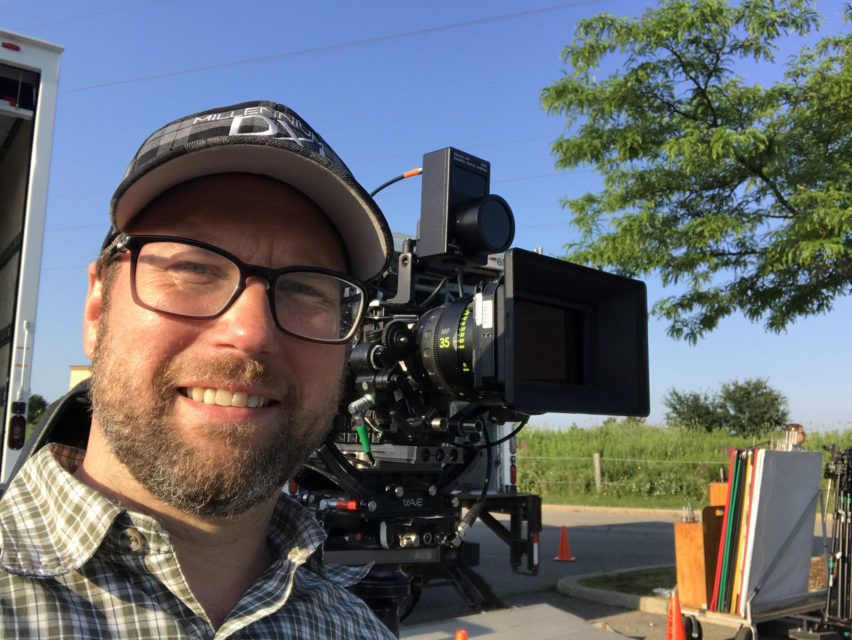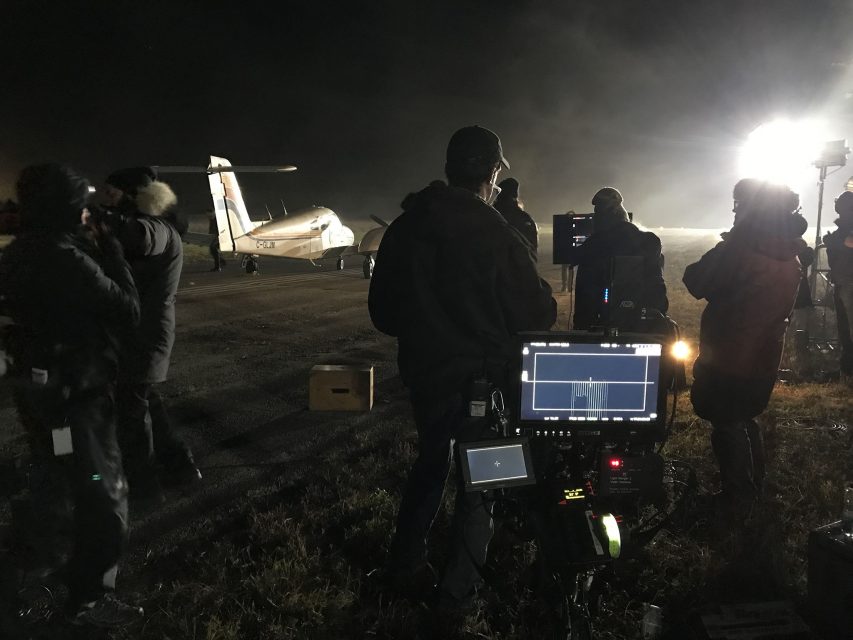Here’s the latest episode in the continuing series, Season Two, of “The Gods of Focus.” Gottfried Pflugbeil has been a Camera Assistant since 1994 and a 1st AC since January 1999. Recently he’s been working on the TV Series “Condor” for MGM and “The Handmaid’s Tale” for MGM/Hulu.
by Gottfried Pflugbeil, Focus Puller / First AC
I was very excited when my Light Ranger 2 arrived. I was told that it was the third one to be sent to Canada. I had been following the development of the LR2 for a number of years, even contacting Howard Preston about the original Light Ranger and asking if it could be rented (it could not).
When the Preston Light Ranger 2 came out, focus tools came to a new level. The LR2 also uses infrared light to calculate the distance, but it takes the idea of a focus tool to two additional levels. First, it has a visual representation of focus, set up on a bar graph that is placed over the image on your monitor. You can identify right away if a subject is closer or farther than where the focus wheel currently sits. Also, when the subject falls within the depth of field, the bar turns green so that you know that the subject is in focus. The second level that sets the LR2 apart is the Autofocus mode. You are given a red box on your monitor that you can move right and left, as well as making the field larger or smaller, in order to pick the exact spot where you want the autofocus to perform. After choosing your red box placement, you can press the Autofocus button on your Preston Hand Unit HU3 and the LR2 takes over, autofocusing your lens completely independently, following your subject closer and farther, as well as adjusting for any camera movement both toward your subject or away.
To make the tool even more usable, you can set limits on the range of the autofocus, from say 5 to 12 feet, so that if an actor sits forward or ducks, the focus does not shift to the background but stops in the exact spot in which the subject exited frame, to readjust the moment the subject re-enters frame. On top of that, there is a “silver-button” trick: when an actor exits the frame, you can press the silver button on the HU3 Hand Unit and the focus stops, which is another extremely beneficial tool.
The first project that I got to use the LR2 on was the Television Series “Condor” with the DP Steve Cosens. We were shooting with ARRI Minis and ZEISS Master Prime lenses.
There was a shot where in a large abandoned factory. Mira Sorvino was just out of frame on a 50mm lens, hand-held. Mira ran into frame towards us as the hand-held camera barrelled backward at a quick pace. The shot held Mira in a close-up for the entire run (about 10 to 15 seconds) before she came upon another actor who was passed out on a couch. The shot went wider at this point as Mira woke up the other actor. There was dialogue and then both actors ran at the hand-held camera, which again ran backwards for about 10 to 15 seconds, and finally with both actors exited the shot at the end. That was a continuous take.
After a rehearsal, I saw that this shot was a perfect opportunity to use the LR2. After action was called, the moment the actors entered the frame I pressed the Auto button on the HU3 to turn on the LR2 Auto Focus. The shot continued with Mira in a closeup frame running straight toward the lens as the camera operator ran backward. When the camera pivoted and the shot got wider I turned off the Auto Focus and controlled the focus manually. This was until close to the end of the shot when Mira and her co-actor started running toward the camera as the camera operator ran backwards again. As soon as Mira filled the red focus box of the LR2, I pressed the Auto button for control by the Preston system. At the very end, as soon as they were about to leave frame, I took the system off of Auto in order for the Autofocus to stop, to have the ending of the shot finish as it should, with the focus stopped as soon as the actors were out of frame.
There was another shot of an intimate dinner in a high-end restaurant. The scene only involved two actors. But, with the nature of a dinner conversation, the swaying back and forth of the actors in their chairs, as well as their leaning forward toward the end of the scene, the scene lent itself well to using the LR2. When we got to the 50mm and 75mm close-ups, I started using the Auto feature on the Light Ranger 2. I set up the Autofocus calibration of the LR2 with my 2nd AC sitting in for the the actor. After it was calibrated, we started shooting the scene, and I turned on Auto and the focus tracked perfectly with the actor— including shifting back and forth, as well as a big lean forward close to the end of the scene.
There was another shot of the actor Max pacing back and forth towards the lens and then away. I used the LR2 for this shot as well. During one of the takes, Max raised his arm right before turning away from the camera and then walked a few feet away. The LR2 was on Autofocus at this point, and as Max’s arm came up, the focus shifted from his face perfectly and back to his face when he lowered his arm. The whole event took only a second, but due to the focus shifting perfectly, I was approached by the operator after the shot to tell me that I had made an amazing shift in focus, perfectly shifting from the actors face, to his raised arm, and then back again. The operator was extremely impressed with the focus move. And I had the Light Ranger 2 to thank for it.
Handmaid’s Tale:
I have a few very interesting shots that I utilized the LR2 on the TV Series “The Handmaid’s Tale – Season 2.” One was a unique shot where we rigged a pulley system that lowered and raised the camera within a small closet. The camera was facing straight down and the actress, Elizabeth Moss, was lying on the floor. The shot started on her face, and very slowly started raising up until she was in a mid-shot, and then the camera lowered again, moving right into her face. Due to the nature of the small closet’s 4 walls all around, there was no way for me to see either the camera or the actress. As the slate exited frame, I turned on the Autofocus of the LR2 and Lizzie’s face snapped into focus, the director called for the camera to be brought up, incrementally, and the focus stayed locked as the camera was brought up, and then down, over and over. The shot looks amazing.
Another example was a high-speed shot. We were framing on a large group of Handmaids rushing the camera and then at the end of the shot exiting. The idea was for the focus to start on the actress closest to the lens and as soon as she exited the focus would need to shift right away to the face of the next actress. This was to be shot at high speed (96 fps) and therefore any subtle tweaks of focus, or focus corrections, would be four times as long because of the nature of high speed.
We slated and I pressed the Auto button and the frenetic shot began. The Handmaids rushed toward us as the camera ran backwards, all at 96 frames per second. As the closest Handmaid’s face exited the shot, the focus seamlessly adjusted perfectly to the next face racing towards the lens. The shot lasted about 15 seconds in real time, but watching playback, it lasted a solid minute, all perfectly in focus. In my opinion, it is the high speed nature of this type of shot that shows the ability of the Lightranger2 to outperform the ability of a focus puller.
Another shot on “The Handmaid’s Tale” was a rainy exterior involving Elizabeth Moss running from a shed to a truck, around the truck, stopping for dialogue, and then running into the back of the truck. We were shooting nights, and this shot was at around 3:00 am. It was decided to do the shot hand-held, with an 85mm lens at T1.3. The depth of field was razor thin. We would shoot the rehearsal. Having no idea where Elizabeth would run, let alone stop, as well having no idea where the camera would stop, or if it would move in for a close-up, I decided that I would put the LR2 to the test and put it on Auto and see what happened while filming the rehearsal. The shot was magical. With the razor thin-depth of field, Elizabeth’s face was captured perfectly as she entered frame, the camera moved closer for dramatic effect, the Preston motors turned perfectly in sync getting their adjustments from the LR2. At the end, Elizabeth ran to the side of the truck, and we continued the shot though the front windshield as she climbed in. It was when she ran past the side of the truck that I turned off the Autofocus and finished the shot manually.
On “Condor,” we shot on the ARRI Alexa Mini cameras and used ZEISS Master Primes (no zooms). “The Handmaid’s Tale” was also shot on ARRI Alexa Mini cameras, with Canon K35 lenses primarily and some ZEISS Super Speeds.
In conclusion, I have found the Preston Light Ranger 2 to be the premium focus tool available. The Lightranger2 gives a visual display of focus on the monitor, showing both depth of field as well as if the focus is in front or behind. And then, as an additional level to that, it has the Auto focusing option that really excels. I would highly recommend the Preston Lightranger2 for all 1st Camera Assistants (Focus Pullers) out there.
Reprinted from Film and Digital Times September 2018 Edition #89-90









